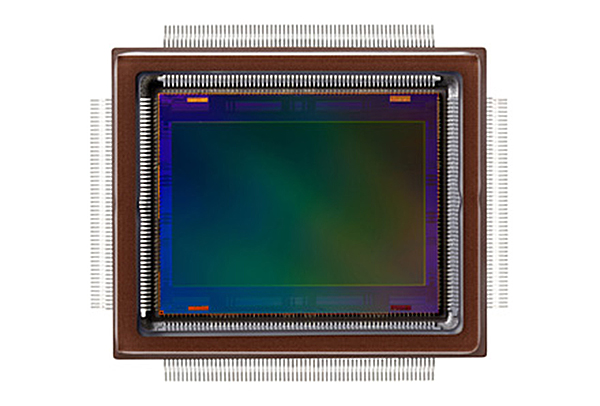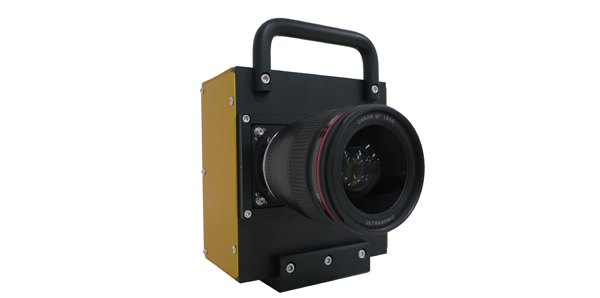

Canon Japan Press Release

Canon's 250 Million Pixel APS-H Sensor
Canon Japan has released information about an APS-H sensor which has the ability to record a 250,000,000 pixel image. Converted to more understandable terms, Canon says they could distinguish a letter on the side of an airplane...from a distance of 18km (~11 miles). This is quite the achievement in sensor technology.

Original Canon Japan Press Release
Show below is the original press release and you can also go directly to the Canon Japan APS-H 250 Million Pixel CMOS Imager press release page.
キヤノンは、35mmフルサイズ以下において世界最高画素数である約2億5,000万画素(19,580×12,600画素)のAPS-HサイズのCMOSセンサーを開発しました。
このたび、新たに開発したのは、APS-Hサイズで世界最高画素数となる約2億5,000万画素のCMOSセンサーです。このセンサーを搭載したカメラを用いて、撮影場所から約18km先を飛行する飛行機の機体文字の識別に成功しました※2。
※2撮影は、光学ズームと電子ズームを組み合わせて行い、撮影した映像の約4万分の1の領域を拡大し、識別しました。
12億5,000万画素/秒の超高速な信号読み出しを実現
CMOSセンサーは、画素数が増えるほど信号量が増加し、信号遅延やタイミングのわずかなずれが問題になります。新開発のCMOSセンサーは、約2億5,000万画素という超多画素でありながら、回路の微細化や信号処理技術を進化させることで、1秒間に12億5,000万画素の超高速な信号読み出しを実現しました。これにより、毎秒5コマのスピードで超多画素な動画を撮影することが可能です。また、キヤノンが長年培ってきたセンサー技術を応用し、画素の微細化に対応した構造を採用することで、超多画素でありながら高感度・低ノイズを実現しました。
フルHD動画の約125倍の超多画素で動画撮影が可能
約2億5,000万画素のCMOSセンサーを搭載したカメラを用いて撮影した動画は、フルHD(1,920×1,080画素)動画の約125倍、4K(3,840×2,160画素)動画の約30倍という超多画素であり、任意の領域をトリミングし、大幅に拡大しても、解像感が損なわれない映像を得ることができます。
キヤノンはこの技術の、特殊監視・防犯機器への応用や、超高精細計測機器・産業機器への応用、映像表現分野への応用などを検討していきます。
30 Times The Resolution Of 4K Video
It's kind of hilarious how the electronics industry brings in a format then it's just gone so fast before consumers get used to it. Once a particular format is announced, we then have everyone piling on comments that it's so much better than the announced format (including the company itself which releases the particular format product). This isn't targeted at Canon at all, but more of a general experience I have had. I just get used to a format, and then that format is extinct before I get a chance to fully use it!
Canon's 250M imager, for lack of a better name since I didn't see one just yet, has the capability to shoot video of about 125x that of HD video (1920 x 1080) and 30 times the resolution of 4K video. The implications are just staggering, and it does appear as if we're seeing new discoveries and breakthroughs in the imaging industry.
Does this mean the Canon $30,000 ME20F-SH video camera will be sold on an upcoming Black Friday deals promotion?
Nope. But keep the wishful thinking alive.
19,580 x 12,600 = Lots Of Pixels
Initially, I hesitated to show the comparison below because there are differences between the two imagers we need to take into account, but this is strictly an image size comparison. Canon's imager is APS-H, which is slightly smaller than the Nikon D750's Full-Frame imager, and the pixel size will also be different. However, if you were to take a photo with both imagers, you would get the below comparison of the size of your image.
Processing Requirements
From the rather limited information from the translated Japan release, the sensor has a data output speed of 1.25Bpps (Billion pixels per second), which could convert to enough readout power to shoot 5 RAW 250MP images per second. Of course, this is going to vary greatly on Canon's RAW file sizes and settings. For example, the sensor might be throttled to only 3FPS or 4FPS to give the output data path enough breathing room. This is because there will be a variance on file sizes, and the buffer of such a processing system could choke on itself.
Using my Nikon D750, I typically get a file size of around 26MB for an NEF file, and 11.5MB for a JPEG file set at the highest possible detail. For a 24.3MP imager you're looking at something 10x the file size. So, a JPEG would be around 115MB, and a RAW file would be...you better sit down...260MB. Per file. And if you're shooting RAW+JPEG, then the file size will probably be around 375MB. Per image.
Pixel Size Of The 250 Million Pixel Monster
Ok, here is where my math classes were finally useful. Hats off to my elementary and high school teachers for keeping me in during recess and forcing me to complete my assignments. I estimate the pixel area to be an amazing 1.55 µm in size. This is assuming a square pixel size, and not taking into account spacing (because that's just impossible unless I had the highly confidential imager spec sheet).
For an imager to get a readable letter from a plane just over 11 miles away, combined with an electronic zoom, is quite astonishing. Electronic zooms are nice to have, but historically, they've only magnified a blurry image, so what you got was...a bigger blurry image. It seems as if Canon has devised a way to increase the pixel count to an overwhelming level, keeping noise to a minimum, which therefore would allow an electronic zoom to operate more like a microscope, instead of a cheap magnifying piece of plastic on an image which had a relatively humble resolution.
The holy grail of imaging, was to achieve a level where you could make an imager with so many pixels, that the combined total pixels would offset the small pixel size. Because the smaller the pixels, the more issues with noise and other interference. The smaller the pixels, the more subject to outside electronic factors play into the overall image clarity. But when we get to a point where an extremely small pixel size can be protected from electronic interference, and this can be translated into hundreds of millions pixels, the clarity of an image is realized into the realms of amazement.
The Future Of Zoom Lenses
Back in 2001 when I was shooting my Olympus E-10, I asked myself, if we get to the point where an imager has so much resolution where I can zoom in on the image in my image editor, effectively creating my own zoom lens...then why buy an expensive zoom lens? If I can buy an expensive 50mm prime lens, and use it with a massive pixel imager, the need for lenses at extended focal lengths beyond 200mm might not be so urgent. Of course, using a zoom lens on a massive imager will increase the "reach" of your zooming capabilities, but for those who cannot afford a $10,000 prime zoom lens (and let's not forget the $25K Sigma 200-500mm f/2.8 zoom lens), buying an exceptional 50mm or even a 35mm prime f/1.4 lens (such as the one Canon used with this imager) for around $1,500 is an exciting concept.
Canon 250 Million Pixel APS-H CMOS Imager
Original News Release: September 7, 2015
This Release: September 7, 2015
Origin Of News Release:
Official Website: Canon Japan
Announcement: Canon announces 250 Million Pixel APS-H CMOS Imager
Notes: 19,580 x 12,600 image size
Availability: Government Applications
MSRP: Not Available
Order A Canon DSLR
Adverts & Promotions